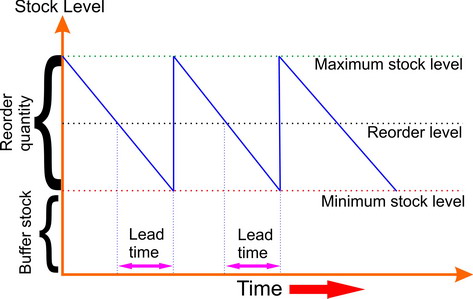Types of Stock
- Raw material
- Work in Progress/Semi-finished goods
- Finished goods
- Consumables
- Plant and machinery spare parts.
Problems due to Overstocking
- More stock more wastage.
- Risk of stock becoming obsolete.
- High storage costs.
- Working capital is tied up.
Problems due to Stockout (total depletion of stock)
- Customers demand could not be met leading to business losses.
- Frequent orders and handling cost may lead to higher cost for the business.
Stock control charts
Maintaining a balanced stock level is important. Stock control chart is one of the methods to maintain optimum level of stock at all times.

Depletion of stocks as a result of usage or sales is represented by the sloping lines. The rate of depletion can be identified from the gradient of the lines. The steeper the gradient, the faster the depletion. When stocks fall to the reorder level, a new batch is ordered. But there is a gap between the order being made and the delivery of supplies, this time gap is known as the lead time. The gap between the minimum stock level and the zero stock level is known as buffer stock.
The following decision need to be taken when managing the stock levels through a stock control chart
- The size of the buffer stock
- The maximum level of stock to be held
- The reorder quantity
- The reorder level





